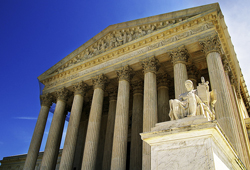 On February 25, 2019, the United States Supreme Court accepted appeal from the Third Circuit’s decision in Rotkiske v. Klemm et al., No. 16-1668 (3d Cir. May 15, 2018). The Court is now primed to answer whether the Fair Debt Collection Practices Act (FDCPA) encompasses the “discovery rule”—which tolls the statute of limitations until a plaintiff discovers he or she has been harmed—even though the relevant portion of the FDCPA, 15 U.S.C. § 1692k(d), limits a cause of action thereunder to “one year from the date on which the violation occurs.” In Rotkiske v. Klemm, No. 18-328, the Supreme Court will have the opportunity resolve a circuit split between the Third Circuit and the Fourth and Ninth Circuits concerning whether the discovery rule applies to the FDCPA.
On February 25, 2019, the United States Supreme Court accepted appeal from the Third Circuit’s decision in Rotkiske v. Klemm et al., No. 16-1668 (3d Cir. May 15, 2018). The Court is now primed to answer whether the Fair Debt Collection Practices Act (FDCPA) encompasses the “discovery rule”—which tolls the statute of limitations until a plaintiff discovers he or she has been harmed—even though the relevant portion of the FDCPA, 15 U.S.C. § 1692k(d), limits a cause of action thereunder to “one year from the date on which the violation occurs.” In Rotkiske v. Klemm, No. 18-328, the Supreme Court will have the opportunity resolve a circuit split between the Third Circuit and the Fourth and Ninth Circuits concerning whether the discovery rule applies to the FDCPA.
The appeal stems from the Third Circuit’s decision in which the court held that petitioner Kevin Rotkiske’s FDCPA claim could not proceed because he filed his case over six years after his alleged injury occurred. The claimed stems from credit card debt Rotkiske amassed during the early 2000s. In an attempt to collect from petitioner, his bank referred the debt to a third-party collector—Klemm & Associates—one of the respondents in the current action. Klemm initiated a lawsuit in an attempt to collect the underlying debt, but failed to properly serve Rotkiske. Klemm instead served a third-party residing at an address where Rotkiske once, but no longer, lived. Klemm eventually obtained a default judgment against Rotkiske in 2009, which he claims he did not discover until he was denied a home loan in 2014. Rotkiske filed his FDCPA claims in 2015, alleging that Klemm and others violated the statute.
The Third Circuit affirmed the district court’s dismissal of Rotkiske’s claims as untimely, holding that the FDCPA’s statute of limitations begins to run from the date of the injury and not from the date the plaintiff discovers that injury. The court specifically declined to “imply a discovery rule” that was not contained within the express language of the statute, and instead “parse[d] [the] limitations period using ordinary principles of statutory analysis.” Using these principles, the court reasoned that the language of 15 U.S.C. § 1692k(d) “spoke clearly” in that the “one-year limitations period begins to run when a would-be defendant violates the FDCPA, not when a potential plaintiff discovers or should have discovered the violation.”
The Third Circuit’s decision is at odds with precedent from the Ninth and Fourth Circuits, which have both held that the FDCPA encompasses the discovery rule and allows plaintiffs to bring claims within one year from the date the plaintiff discovers or should have discovered the alleged injury. These courts have reasoned that precedent dictates the discovery rule typically applies broadly across federal statutes, even when the rule is not contained within a statute’s express provisions. The Third Circuit expressly rejected this reasoning, and faulted the Fourth and Ninth Circuits for “fail[ing] to engage the statutory text.”
The result of the circuit split is thus that litigants in the Ninth and Fourth Circuits will have one year from the date upon which he or she uncovers the injury to bring a claim under the FDCPA. Conversely, litigants in the Third Circuit are required to bring their FDCPA claims within one year from the date upon which the violation occurs—often shortening the period within which FDCPA plaintiffs can bring their claims. The Court appears set to resolve these differing outcomes such that plaintiffs and debt collectors alike will be given guidance on the discovery rule’s applicability to the FDCPA.

